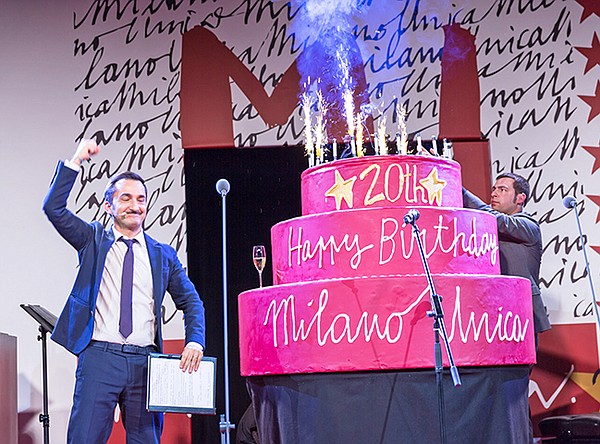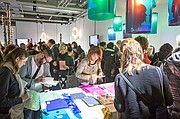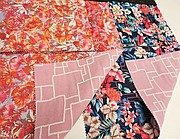Italian TV and radio host Nicolo Savino hosted Milano Unica’s opening-night party, celebrating its 10th anniversary.
TRADE SHOW
Milano Unica Celebrates 10 Years, Turns Its Eye to New York
MILAN, Italy—Milano Unica, the European textile trade show formed when several well-established Italian trade shows—including IdeaBiella, Moda In and Shirt Avenue—joined forces 10 years ago, is preparing to launch its first New York show in July.
The trade show took its showcase of Italian fabrics and trim to Shanghai in 2013, when it began exhibiting at the giant Intertextile Shanghai trade show. It has yet to be determined whether the Milano Unica show in New York will be an independent show or in partnership with an existing trade show.
“Milano Unica abroad is a good partner to have,” said Silvio Albini, president of Milano Unica and director general of the Albini Group, speaking during Milano Unica’s Feb. 4–6 run at the Fiera Milanocity in Milan. “We definitely have people who are asking Milano Unica to be with them.”
Many longtime Milano Unica exhibitors already have a presence in New York, either with their own local sales representative or by showing in one of the existing trade shows in New York such as Première Vision Preview New York, Texworld USA or Kingpins.
Michele Vigano, co-owner of Italian textile converter Seterie Argenti, based in Como, shows in New York at Première Vision Preview and employs a New York–based sales rep.
“I think [Milano Unica New York] is a good idea,” he said. “It’s a good way to show what Italy has to offer [in a] nice show with all the good Italian companies and not spread around the city.”
Vigano was at the recent Milano Unica show in Milan with a newly launched higher-end collection, Black Label, which uses finer yarns and is targeted as “more for the designer level,” Vigano said, who added that the show turnout was good.
“It was better than we expected and much more than a year ago,” he said. “The quality of the customers was not excellent [there were a lot of smaller designers], but generally we are happy.”
Vigano said he primarily met with Italian customers and companies but expected to see more international designers at the Première Vision show in Paris the following week. Like many exhibitors at Milano Unica, Vigano has already showed his line in New York at Première Vision Preview and at Munich Fabric Start in Germany before taking the line to Milan and Paris.
This season, the Argenti collection included jacquards, stripes, colors and prints.
“People are asking for special base goods like clipped jacquard and devoré or yarn-dye backgrounds like stripes. Something with added value,” Vigano said.
At the booth for Como-based mill Taiana, Marketing Manager Marco Taiana was showing the latest offerings from the company’s men’s line Taiana Cult and its women’s line Taiana Vanity. (The company shows its swim line, Taiana Blu, at the Mare di Moda swim show in Cannes.)
For men, Taiana was showing yarn-dye woven fabrics, including jacquards and inkjet prints in engineered scenic patterns, stripes, geometrics and ombré microdesigns. The company’s new Rainbow Lightning fabrics feature a multi-color yarn on a dark ground, and its Dynamic Printing group features a special design made by printing on crushed fabric, which is then flattened out to give the design another layer of pattern detail. There were also stretch jacquards with the look of an embroidered fabric. For women, Taiana was showing double-faced jacquards, lightweight organzas and seersucker.
Last year, Grandate, Italy–based mill Teseo s.p.a. introduced a line of GOTS-certified fabrics based on some of the mill’s best-selling fabrications: organza, crêpe satin, crêpe de chine and georgette. The fabrics are supply-chain certified from yarn to weaving to dyeing, said company representative Luca Clerica.
“We introduced it one year ago, then improved the quality six months ago. At first, we were only producing white. Now we have a range of colors, and we stock all of them,” he said.
Clerica said several major Teseo customers are producing eco-friendly collections.
Piobesi D’alba, Italy–based mill Miroglio introduced a new collection of digital prints on natural fabrics, said Carlo Marone, who represents the Miroglio Lana and E Miroglio collections. Currently, the digital prints are produced in Italy, but soon the company will set up production in Bulgaria, where it produces the rest of its collection.
Ten years ago, the company shifted production to Bulgaria, where it today employs 2,300 people in a vertical operation.
Marone said with the addition of prints, Miroglio now offers “360 degrees of business.”
“Now we are complete,” he said.
Business at the Miroglio booth got off to a good start with strong turnout from all over the world, Marone said.
“For us, it was a really good day,” he said on the opening day of the show. “We had customers from all over the world. Mostly Italy but also two or three from France, two from Germany and several from Eastern Europe.”
Marone said he had not seen many companies from Russia, which has been a good market for Miroglio, but he expected to see a greater turnout overall in Paris the following week.
The first day was also good for Isabelle Dupy, export manager for French lines Trouillet and Angie.
“For us, it’s a really good show. It’s always interesting to be here,” she said.
The company launched a new women’s range called Tecmoda, which Dupy described as aimed at a slightly older customer than the typical Trouillet young woman.
U.K. print house Liberty Art Fabrics was showing its new collection created by new designer Tessa Birch.
“The theme was the artist,” said Grace Sisto, who works in customer service for Liberty. “You can see the hand of the artist in the prints.”
The new collection is a bit of a departure from Liberty’s traditional botanical patterns, Sisto said, but the company also included some floral prints for its childrenswear and “classic” customers.
Sisto said the company was seeing a mix of existing and new customers at Milano Unica.
“We saw the usual customers and some new—despite the weather,” she said on the second day of the show, when a steady snowfall powdered much of the city.
Hugo Soudée, sales manager for Soultz, France–based Philea, said he was seeing nearly all Italian companies at Milano Unica. Philea was showing “newness in each category,” including new crêpes, new jacquards and new prints.
Soudée, who covers the U.S., U.K. and French markets for Philea, said buyers’ moods vary depending on the region.
“In the U.S., people are more optimistic [because] the economy [is getting stronger],” he said. In France, the mood is more conservative, he said.
“Italy is between the two worlds,” he said. “They tend to be conservative about price. The buyers are going for safe [items] but are looking for beautiful, tasteful and simple [fabrics]. They’re not going for the bling bling.”
According to Albini, Milano Unica’s president, the past 10 years have been challenging for Italy, but there are signs that the market is improving.
“We have seen good signs at last for international Italian demand—and that is very good news,” he said. “We had a long period of very depressed internal market.”
The exporting of Italian fabric to the U.S. and Eastern Europe is growing, Albini said, adding that the demand from Eastern Europe indicates that companies are looking to move production from the Far East back to Europe. China also remains a strong market for Italian textiles, he said.
“Our view of the Chinese market is long-term,” he said.
Still, Albini acknowledged the forecast for the international market remains challenging.
“2015 has started with some clouds in the sky. I cannot deny what is happening in this turbulent world is affecting our customers,” he said, pointing to the crisis in Russia and Ukraine and the devaluation of the Russian ruble, conflict in the Middle East, Chinese austerity, and deflation in Brazil and Latin American countries.
“But I’m not pessimistic,” he said. “Looking forward, things should improve.The best garment manufacturers are full of work—this is a sign of big changes happening.”
The more-favorable exchange rate for the euro should help boost sales.
“We have been able to export 55 percent with a euro that has been extremely high—too high,” he said, adding that things should improve with a more balanced rate.
“We are definitely export-oriented. That should also balance the convenience of imports.
“The mood in Italy is step-by-step change. I’m very aware that being united together is the right way to be successful in the international market.”
For the second season, Milano Unica featured Japan Observatory, a dedicated pavilion of Japanese mills organized in partnership with the Japan Fashion Week Organization. Albini said the show intends to expand the concept with additional countries, although he declined to say which countries might be invited.
“Milano Unica wants to represent the best fabric product in the world,” he said. “That will be criteria with which we will be admitting enterprises from other parts of the world. Important Italian fashion houses have asked for textile producers—from Japan first and also some other parts of the world.”
Show organizers are also interested in creating a special denim presentation. The recent show featured Denim Italiano, a denim supply-chain trend forum organized by Milano Unica and Pitti Immagine. The forum included a denim burnout print in an oversize houndstooth pattern from Confezioni Vestire, embossed printed animal patterns on denim from I.T.V. Industria Tessile Del Vomano s.r.l., a dense ribbed fabric made into a jacket and then washed down to show the variations from Candiani Denim, art nouveau prints on denim from Stamperia Toscana, oversize wallpaper foulard florals and photo-realistic giant blooms by Lanificio Europa, and wash techniques ranging from antiqued stencil designs to copper foulard prints from Martelli Lavanderie Tessili.
In Milano Unica’s accessories section, there were Mod enamel buttons in bright colors from Visma SRP and oversized buttons that looked like iridescent marbles from Astarte SRL Unipersonale. Art Lin s.r.l. was showing foam moulding, embossing, appliqués and photo-realistic printing, and Ramponi was showing nailheads in different shapes and sizes overlayed with a laser-cut fabric.

























